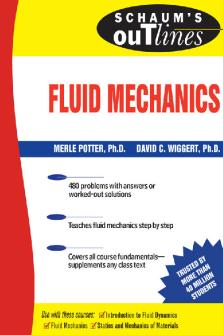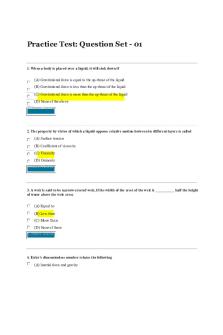Fluid Mechanics Cheat Sheet PDF

| Title | Fluid Mechanics Cheat Sheet |
|---|---|
| Author | kay chal |
| Course | Fluid Mechanics |
| Institution | K L Deemed to be University |
| Pages | 3 |
| File Size | 190.7 KB |
| File Type | |
| Total Downloads | 22 |
| Total Views | 144 |
Summary
Cheat Sheet...
Description
Material Derivative:
)Π ∙ ∇ D୲ Π = ∂୲ Π + (V
Conservation of Mass:
∙ ρV 0 = ∂୲ ρ + ∇ ∙ V + V ∙ ∇ ρ 0 = ∂୲ ρ + ρ∇
/ୌ ∙ d) 0 = ∂୲ ρ d + ρ (V
= 0 Using ∂୲ ρ = 0 and Ma < 0.3 we get incompressible continuity: ∇∙ V େ
ୌ
Conservation of Linear Momentum:
P + ∇ ∙ τ = ρD ୲ V ρg − ∇
d + ρV (V = ∂୲ ρV /ୌ ∙ d) ∑F େ
ୌ
d + ρV (V /ୌ ∙ d) ∑F − a ୶୷/ଡ଼ଢ଼dm = ∂୲ ρV − ma୶୷/ଡ଼ଢ଼ = m ୭ u୭ − m ୧ u୧ ∑F େ
ୌ
∂ ୶τ ୶୶ + ∂ ୷τ ୷୶ + ∂ τ ୶ ∂ ୲ V୶ + V୶ ∂୶ V୶ + V୷ ∂ ୷V ୶ + V ∂ V୶ ∂ ୶P g୶ ρ g ୷ − ∂୷P + ∂ ୶ τ ୶୷ + ∂ ୷τ ୷୷ + ∂ τ ୷ = ρ ∂ ୲ V୷ + V୶ ∂୶ V୷ + V୷ ∂ ୷V ୷ + V ∂ V୷ g ∂ P ∂ ୶ τ ୶ + ∂ ୷τ ୷ + ∂ τ ∂ ୲ V + V୶ ∂୶ V + V୷ ∂ ୷V + V ∂ V
V and τ ୧୨ = τ୨୧ = µ(∂୧V୨ + ∂ ୨ V୧ ) thus momentum balance yields the Navier-Stokes Equation: For Newtonian Fluids τ = µ∇ = ρD୲ V ρg − ∇ P + µ∇ ଶV
∂ଶ୶୶ V୶ + ∂ଶ୷୷ V୶ + ∂ଶ V୶ ∂ ୲ V୶ + V୶ ∂୶ V୶ + V୷ ∂୷ V୶ + V ∂ V୶ ∂୶P g୶ ଶ ଶ ଶ ∂ g P ∂ V + ∂ V + ∂ V ∂ ρ ୷ − ୷ + µ ୶୶ ୷ ୷୷ ୷ ୷ = ρ ୲V ୷ + V୶ ∂୶ V୷ + V୷ ∂୷ V୷ + V ∂ V୷ g ଶ ଶ P ∂ ∂୲ V + V୶ ∂ ୶V + V୷ ∂୷ V + V ∂ V ∂ ୶୶V + ∂୷୷ V + ∂ଶ V
For Inviscid Flow we set τ ≡ 0 thus momentum balance yields the Euler Equation: − ∇ P = ρD୲ V ρg
∂୲ V ୶ + V୶ ∂୶ V୶ + V୷ ∂୷V୶ + V ∂ V୶ ∂୶ P g୶ ρ g ୷ − ∂୷ P = ρ ∂ ୲ V୷ + V୶ ∂୶ V୷ + V୷ ∂୷V୷ + V ∂ V୷ g ∂ P ∂ ୲ V + V୶ ∂୶ V + V୷ ∂୷V + V ∂ V Bernoulli’s Equation: This equation applies for frictionless flow along a streamline: 1 ∂୲ V ds + dp + VdV + gdz = 0 ρ
If we assume the flow steady and incompressible and integrate over a streamline we get: pଶ − pଵ Vଶଶ − Vଵଶ + + g(z ଶ − zଵ) = 0 2 ρ
Conservation of Angular Momentum:
Euler’s Turbine Formula: T = ρQrଶV୲ଶ − rଵ V୲ଵ ; Q=V nA
= ∂୲ ρr ×Vd + ρr × V (V /ୌ ∙ d) ∑M େ
Sprinkler Formula: ω =
ୌ
బ ୖ
−
బ
ρ୕ୖమ
Conservation of Energy: /ୌ ∙ d D୲ E = 0 = D୲ Q + D୲ W = ∂୲ ρed + ρh + 0.5V ଶ + gzV େ
/ୌ ∙ d D୲W = − ρV ୌ
ୌ
/ୌ ∙ d D ୲ W = τ ∙ V ୌ
Under steady state the energy equation for an incompressible flow becomes similar to the Bernoulli’s Equation:
2 p p αV 2 αV = + + + z + z in ρg ρg 2g 2g 2 1 up
out down
+ hfriction − hpump + hturbine
;
h=
Power ρgQ
This motivates defining the Hydraulic Grade line which shows the energy head minus the velocity head. Reynolds Number: It is the ratio of inertial to viscous forces thus gives a measure of the turbulence: Re =
m V τA
=
2 r LL L Inertial ρVr ∂ rVr ρV 0.5ρ Vr = Re = = = ି2 2 V R µ R Viscous µ ∂ zz r 0.5L µRVr
ρV ρVL VL ρVଶA = = = μVA ÷ L ν μ μA
p A + ρ1 gh − ρ2 gh = pB p A − pB =
Manometery and Surface Tension:
yields
ρ2 − ρ 1 gh
How to use the Right Equation: In essence we have Linear Momentum: +Frictionless or Inviscid Euler’s Equation +Integration over streamline Bernoulli’s Equation The Nabla Operator in Cylindrical Coordinates: 1 1 1 + ∂r ∂r (r ∙) ∂r(r ∂r ∙) r r r 2 1 ∇= 1 = ∇ = 1 2 ∂ ∂θ ∂θ r2 θθ r r ∂ z ∂z ∂2zz ≠ 0 : = ∇ × V A Fluid becomes rotational if ζ = 2ω *It is Viscous *Non-Inertial forces act upon it
dF = dL ; dE = dA
+Incompressibility Head Equation +Irrotationality Uniform Bernoulli Constant
1 Dt Π = ∂tΠ + (Vr ∂r + Vθ ∂ θ + Vz ∂ z)Π r
*It feels Entropy gradients *It feels Density gradients
Laminar Flow Equations and the Friction Factor: Without pumps and turbines and applying the energy head equation in a pipe we get: 4 p1 − p 2 32µLV 128µLQ π∆pd h f = z1 − z2 + = = for laminar only and note that Q = 2 4 128µL ρg ρgd πρgd Moreover the momentum equation equates the right hand side to L V2 4τL hf = f hf = where f = fcnRe , ε ÷ d, shape ∗ i d 2g ρgd Equating at first then assuming laminar flow gives: 5 π2 ghfd 8τ d 2g 8(8µV ÷ d) 64 ∗ ii flam = f = hf ∗ iii = = = 2 2 2 8 LQ LV Re ρV 2 ρV Moody Chart Formulas: Colebrook Formula: ε ÷ d 2.51 1 + = −2 log10 " # 3.7 Re√f √f Haaland Formula: ε ÷ d 1.11 6.9 1 = −1.8 log10 " # + 3.7 Re √f
Dimensionless Head Loss Parameter: gd3 h f f Re2 ζ= = Lυ 2 2 ε ÷ d 1.775 ζ Re = −$8ζ log10 = + 3.7 $ζ Turbulent↑ Laminar↑
Pipe Flow and Design Problems: +Head Loss Problem(L,d,V): Get Re, then find f by formulas or charts then get hf . +Flow Rate Problem(L,d,hf): Get the dimensionless head loss parameter, then deduce Re by the second formula, finally get V from Re.OR: Get f by (i) which gives a relation of the type V=(C÷f)0.5 . Then guess f, get V and hence Re, then get a better f. +Pipe Diameter Problem(L,V,hf): Using ii to relate f and d (1), get Re in terms of d (2), get roughness in terms of d (3). Then guess f, get d from (1) get Re from (2), and the surface roughness from (3) then compute a better f. +Pipe Length Problem(V,d,hf ): Get hp by dividing power by ρgQ, compute Re and the shape factor then get f by Colebrook or Haaland formula. Finally set hp and h f equal and get L.
Piping Systems: ∆h = h f + h minor = Dimensions: Length Area Volume Velocity Acceleration Volume flow
-1
L 2 L L3 LT-1 LT-2 L3 T- 1
Mass flow MT -1 - 2 Pressure ML T -1 Strain rate T Angle 1 Ang. speed T- 1 Viscosity ML-1 T- 1
V2 fL " + ΣK# 2g D 2 -1
Kin Viscosity L T -2 Surface Ten. MT Force MLT - 2 Moment ML2 T- 2 Power ML2 T- 3 Energy ML2 T- 2
-3
Density ML Temperature Θ Sp. Heat L2 T-2Θ-1 Sp. Weight ML-2T-2 Conductivity MLT- 3 Θ-1 Expansion Θ-1
Solving Multiple Pipe Systems: In Series the first equation would be setting the flows equal. Then find the total head loss for the system as a CV by getting ∆z+∆p÷ρg and set it equal to the sum of individual head losses in every portion of the system. Estimate the individual friction factors, get one velocity, get the all Re of the system and figure a better estimate of the friction factors by Haaland’s relation. In parallel again find the head loss for the system as one CV. Then set this head loss equal to individual head losses in every portion. The problem now is just as the Flow Rate Problem above where we solve for the individual friction factors and velocities one at a time. In a junction we set the HGL height at the meeting point to be hJ (initial guess would be the intermediate value of zi )and so ∆h i=z ihJ , for each member this yields a relation between the individual friction factors and velocities. Then we calculate the dimensionless head loss parameter ζ and deduce Re. Afterwards we get the friction factor and hence the velocity and we do that for every element. Fill out the following table and sum the flow rates: if the sum is positive increase the guess of Jhand if the sum is negative use a lower hJ . Repeat the iteration till the sum of flow rates converges to zero. Reservoir
hJ (guessed)
zi - h J
Turbulent Modeling:
fi
Vi
1 ρR u = ln " ∗ # + 5 ∗ 0.41 u u
Where u is the centerline velocity then to get other parameters: τ w = ρu ∗ 2
V = 0.85u ∆p =
Extra Formulae: 3
β=
gh fQ Lυ5
σ=
ευ Q
Re 2.5 = −2 "
2τw∆L for horizontal pipe (see ∗ i) R 2.51Re1.5 128β 0.5 πσRe + log # 10 14.8 128β ÷ π3 0.5 π3
Qi...
Similar Free PDFs

Fluid Mechanics Cheat Sheet
- 3 Pages

Fluid & Electrolytes Cheat Sheet
- 1 Pages

Fluid mechanics - Answer sheet 4
- 6 Pages

Fluid Mechanics
- 260 Pages

Fluid Mechanics
- 796 Pages

Fluid Mechanics
- 8 Pages

fluid mechanics
- 8 Pages

Fluid mechanics history essay
- 16 Pages

Nestle - Summary Fluid Mechanics
- 3 Pages

Fluid Mechanics 2 MCQ
- 109 Pages

Fluid Mechanics Lab Report
- 35 Pages

Fluid Mechanics lecture notes
- 133 Pages

Introduction to Fluid Mechanics
- 321 Pages
Popular Institutions
- Tinajero National High School - Annex
- Politeknik Caltex Riau
- Yokohama City University
- SGT University
- University of Al-Qadisiyah
- Divine Word College of Vigan
- Techniek College Rotterdam
- Universidade de Santiago
- Universiti Teknologi MARA Cawangan Johor Kampus Pasir Gudang
- Poltekkes Kemenkes Yogyakarta
- Baguio City National High School
- Colegio san marcos
- preparatoria uno
- Centro de Bachillerato Tecnológico Industrial y de Servicios No. 107
- Dalian Maritime University
- Quang Trung Secondary School
- Colegio Tecnológico en Informática
- Corporación Regional de Educación Superior
- Grupo CEDVA
- Dar Al Uloom University
- Centro de Estudios Preuniversitarios de la Universidad Nacional de Ingeniería
- 上智大学
- Aakash International School, Nuna Majara
- San Felipe Neri Catholic School
- Kang Chiao International School - New Taipei City
- Misamis Occidental National High School
- Institución Educativa Escuela Normal Juan Ladrilleros
- Kolehiyo ng Pantukan
- Batanes State College
- Instituto Continental
- Sekolah Menengah Kejuruan Kesehatan Kaltara (Tarakan)
- Colegio de La Inmaculada Concepcion - Cebu


